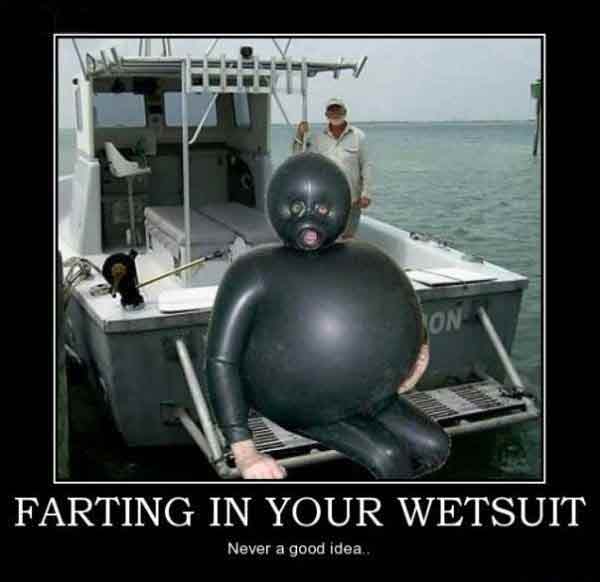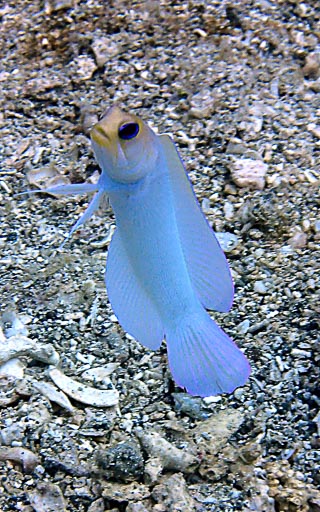The definitive guide to buying a wetsuit.
A Wetsuit is big investment, this is what you need to know to purchase the right one.
A wetsuit, while seemingly a pretty simple garment is actually more complicated to buy than what you first believe. Here is the definitive guide to purchasing your ideal wetsuit.
How A Wetsuit Works
Wetsuits, or exposure protection suits as they are more correctly named are not meant to keep your body dry.
Wetsuits work by trapping a thin layer of water between your skin and the suit, your body warms this water and this prevents you from losing too much body heat when diving. (Remember water conducts heat away 25 times faster than air).
The wetsuit material (Neoprene or similiar) adds insulation by trapping the water and thus keeping the heat in.
The thicker the Neoprene, the more insulation and the warmer you are.
The downside is that the thicker the suit, the more inherent buoyancy it has and the more weight you will need to carry.
Wetsuit Construction
Basic Construction
Wetsuits are made from Neoprene, there are many different grades of Neoprene, some grades are much more flexible than others, flexibility is important for comfort and a good fit.
The cheaper wetsuits will use the same thickness and type of Neoprene throughout the whole suit, this is fine on a 2 mm “shorty” for the average diver.
The more expensive suits will use different thickness and different types of Neoprene in different areas of the suit, this gives a better fit and a more flexible suit.
For a rule of thumb, the thicker the suit you are buying, the more important the quality is, donning a 5 mm or 7 mm suit is not easy and good construction helps tremendously.
Seams and Stitching
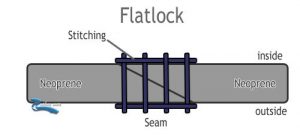
Seams are a critical component of your wetsuit, seams can be sewn, glued, taped or any combination of the three.
The most common seam is made by using a “Flatlock Stitch”, multiple needles are used and the seam, once sewn it lies flat on the body for a comfortable fit. This type of seam, while being excellent for flexibility, does allow water to leak through the seam so it is only suitable for suits 3 mm and under.
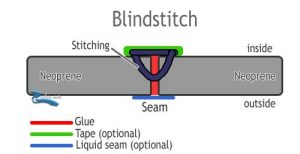
The second type of seam is a “Blind Stitch”, here the seams are first bonded together, making the seams waterproof and then when stitched the needles only penetrate through half the thickness of the material, this is why it is called a “Blind Stitch”
In addition to stitching, seals can also be taped or “liquid welded” on the inside.
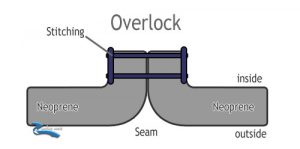
A very cheap way of stitching a suit is the “overlock” stitch, the edges are rolled together and stitched through, this leaves a noticeable bulge on the inside which is uncomfortable, found in your local Wal-Mart or similar.
Zippers
Zippers can be across the chest, at the back or at the front, it all depends on the style of the suit.
Inexpensive suits will have a simple zipper with a flap of Neoprene underneath to help prevent water seepage. More expensive suits will have a high quality zipper with overlapping teeth to prevents water getting through the zip. A really good suit will have a sealing system or flap underneath to stop that “water trickling down your back” feeling.
Some modern suits are made “zipless” ideal for sealing but not easy to get into.
Seals
Seals at the neck, ankles and wrists are important, if water is trickling in through these then your body has to keep warming it up again and you lose body heat.
Depending on the suit you will find simple elastic seals, seals made from “Smooth Skin” (or a different brand name), seals that roll over and, on thicker suits, seals with zips at the ankles and wrists. The more effective the seal, the more effective the suit is at keeping you warm.
Zips at the wrists and ankles mean that seals can fit better while making the suit much easier to get into.
Linings
Many good wetsuits have lining at the seals for better fit. Thicker suits also have a lining on the suit body, this is usually a microfiber fleece type of material, this increases body warmth and makes the suit easier to get into.
Wetsuit Accessories
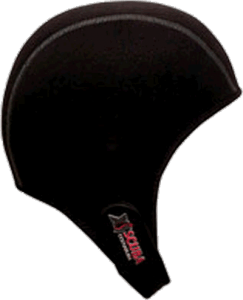
Depending on water temperature you may consider, gloves, boots and hoods. These also come in various style and thicknesses.
A hood is very effective at keeping you warm as 20% of body heat is lost through the head.
1 mm and 2 mm “jockey caps” are available for warm water diving.
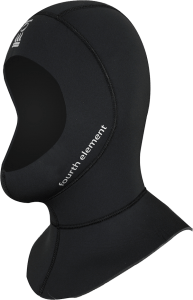
Wetsuit styles – what to consider
Zipper Placement
Back Zip – This Zipper goes straight down your spine, the classic style of wetsuit. Very easy to get into and out of, with care you can zip up / zip down all by yourself.
Front Zip – Same as back zip but the zip is straight down the front of your body, Easiest suit to get into but you may need your buddy to assist in getting the suit off your shoulders when undressing.
Chest Zip – The zip is placed diagonally along your chest, you enter the suit through a cutout below the neck and then pull the neck section over your head.
These diagonal chest zip suits are definitely the best for sealing and preventing leaks, BUT they are very tricky to get into and out of. Once you are in it, it will be tremendously comfortable, but personally i don’t like to fight my suit!
No Zip – A relatively new design, you “climb in” through the top and pull the rest of the suit over your head. Excellent design for fitting but again, tricky to put on and take off.
Body Style
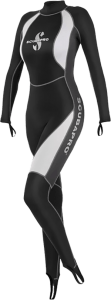
Skins – made from Lycra or 1 mm Neoprene. These are great to prevent stings or scratches in very warm water or for wearing under a 5 mm or 7 mm suit to make it easier to get into. (If buying a skin for this purpose make sure it has foot stirrups and thumb hooks)
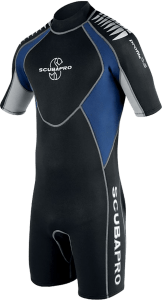
Shorty / Spring Suit – covers your torso, leaves arms and legs bare. Basic suit for warm water diving.
You can also layer a 3 mm shorty over a 3 mm full suit to give extra insulation on your torso.
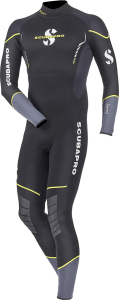
Full Suit – covers your whole body. Thickness from 2 mm to 7 mm.
You will also see full suits referred to as 3 / 2 or 5 / 3, this means the torso of the suit uses a thicker neoprene, while the panels that need to flex and stretch use a thinner material, this makes for a great fit.
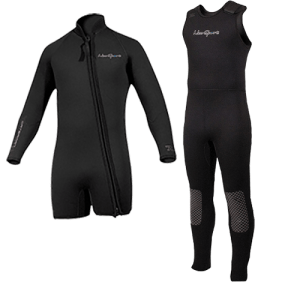
Farmer John / Long John / Long Jane – 2 separate pieces, one for your legs and torso, one for your arms and torso. These are for cold water and the big advantage is you get double the neoprene on your torso, the area most likely to get cold.
Wetsuit Fitting
Putting it simply, for a wetsuit to do its job, it has to fit.
If your suit is baggy at the crotch, baggy at the armpits, baggy at the elbows and too loose at the neck then you might as well not be wearing it.
All that spare material creates air pockets and increases buoyancy, any ill fitting seam lets water flow through.
Too tight across the chest can restrict breathing, as can a too tight neck seal
Wetsuit Sizing
There is no true standardization across sizes between manufacturers, one manufacturers Large can be another manufacturers Medium.
Ladies suits are cut for female body shapes, more room in the areas that need it.
In the more expensive suits you actually get more sizes:
Basic Adult Wetsuit Sizes
XS
SML
MED
LGE
XL
XXL
The smaller size range means that if you are shorter or taller than average it is hard to find a good fitting suit.
The extended size range means a good fit for 99% of divers
Suits offered in the extended size ranges also tend to be made from better, more flexible neoprene of varying panel thickness which helps to get that really snug fit. When you buy a “short” or “long” fitting then torso length is different along with the arm and leg length.
Obviously these suits are more expensive, but as with most things in life, you get what you pay for and the value of quality far outlives the short term benefit of saving a little money.
Extended Adult Wetsuit size range
XS (Short)
XS
XS (Tall)
MED (Short)
MED
MED (Tall)
LGE (Short)
LGE
LGE(Tall)
XL (Short)
XL
XL (Tall)
XXL (Short)
XXL
XXL (Tall)
What thickness of suit should I buy?
This depends on two factors:
Your own personal tolerance for water temperature, and what your body has grown accustomed to.
The water temperature you will be diving in.
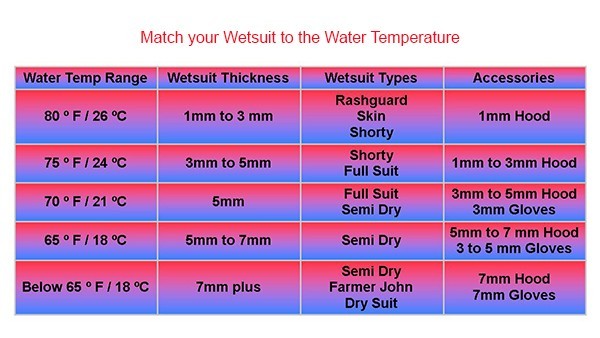
We all have a different tolerance for cold.
Here in St Kitts 90% of our guests who rent suits are happy with a 3 mm shorty, we do however keep a few 3 mm full suits, especially for divers who feel the cold.
Our water temperature is 84° F/ 28° C for most of the year, dropping to 79° F / 26° C in the winter.
Many of our divers just wear a rash guard all year.
At the other end of the scale, a number of divers who know they are sensitive to water temperatures bring their own 5 mm full suits to dive in.
Personally. I came to the Caribbean from the UK, I was used to drysuit diving in water that never exceeded 60° F/15° C . Most of the time was more like 50° F/10° C.
For the first 2 years in St Kitts I wore only a rash vest, whatever the temperature.
Nowadays, after 13 years here, I wear a 3 mm Shorty for most of the year (except the summer months) and a 3 mm Full Suit for the winter.
Remember the value of layering, for warmer water if you feel comfortable in a 3 mm full suit you can always layer a 3 mm shorty over the top for extra warmth.
Taking care of your wetsuit
Do not stress the zip (or the zip pull) when putting it on or taking it off, get your buddy to help you.
Do not overly pull on the suit to get it on, I tell new divers that suits should be on like “panty hose” bottoms first, pulled all the way into the crotch, then put the arms in.
With a thicker 5 mm or 7 mm suit it helps to wear a skin underneath or to put your feet / hands in plastic bags when donning the suit.
Wash in clean water, dry out of the sun, Do NOT machine wash or tumble dry.
Use “wetsuit wash” products sparingly (useful if you have peed in the suit).
Occasionally take a toothbrush to the zipper, clean out any grime and lubricate with a little “Zipper Lube” or Silicone – this reduces friction and extends the life of the Zipper.
Try not to pee in your own suit and never, ever, pee in a rental suit.
Buoyancy and wetsuits
We all know that the thicker the suit, the more buoyancy it has and the more weight we will need to achieve neutral buoyancy.
But did you know that suits lose buoyancy over time?
Each time you dive the neoprene compresses and little by little it stays compressed, this reduces its buoyancy factor (and its insulation factor).
I have found that new suits will lose some initial buoyancy after about 10 dives then stay that way for many dives after.
My suits after 300 dives usually look pretty good, and have very, very, little buoyancy. Unfortunately they also have very little insulation value left.
The Perfect Wetsuit for you
Somewhere out there is a perfect wetsuit for you. It will fit like a glove and you will feel so comfortable and warm in it.
It may not be easy to find, you may have to try on a good number of suits.
Your suit may cost you more money than you budgeted for but if you care for it properly a good suit last a long time. (I get around 300 dives over a season out of a single suit).
When choosing your suit:
Spend time trying different suits on.
Take a buddy with you so fit can be checked from all angles.
“Buy the Suit” that is right for you, don’t allow yourself be “sold a suit” for any reason.
Color does not matter, fit does.
Remember the value of “layering”
Don’t forget hoods and gloves.
Buy a suit for Scuba, not for Surfing, the flex panels are different.
